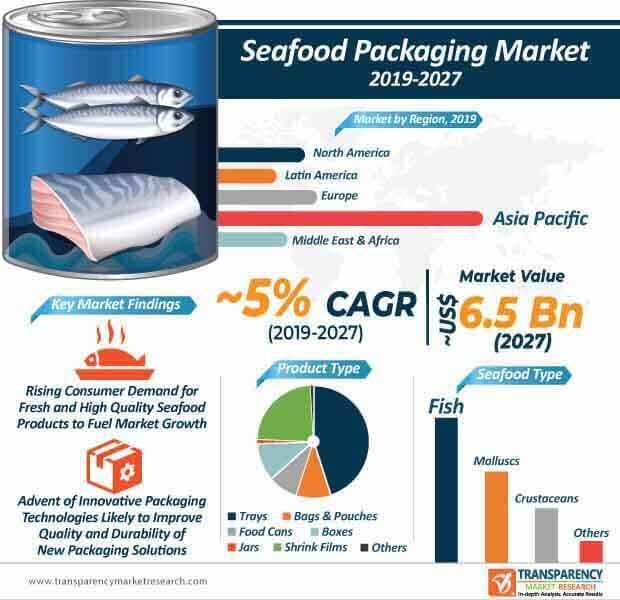
According to the Food and Agriculture Organization (FAO), fish production is set to grow by around 18% in the next 10 years. Investments in the seafood production sector continue to pour in to strengthen fisheries management regimes, minimizing waste, and mitigate losses during transportation. As seafood production is set for inevitable growth in the coming years, stakeholders in the seafood packaging market are continually finding new ways to preserve the freshness of fresh products and minimize exposure to external factors that hinder the same. Seafood packaging has thus, gained a significant amount of traction in recent years, wherein new technologies are being deployed to improve the quality and durability of new packaging solutions.
At present, modified atmosphere packaging and vacuum packaging technology are increasingly being used for seafood packaging. In the current scenario, the growing demand for fresh seafood, particularly in the Asia Pacific region has compelled stakeholders in the seafood packaging market landscape to deploy different types of seafood packaging products, including food cans, shrink films, boxes, and bags & pouches. Stakeholders in the current market landscape are also focused on offering effective seafood packaging solutions that are ideal for shipments across large distances. These factors coupled with a significant rise in consumer demand for high-quality seafood products is expected to drive the global seafood packaging market past ~US$ 6.5 Bn by the end of 2027.

Request a sample to get extensive insights into the Seafood Packaging Market
Innovations in Packaging Technologies to Trigger Market Growth
Over the past decade, technological advancements in the packaging sector have opened the gates for new packaging solutions that are cost-effective and highly reliable. The development of new packaging alternatives in the seafood space, primarily aim to curb enzymatic reactions and improve the perishability of seafood products. At present, key participants of the seafood packaging market predominantly favor modified atmosphere packaging (MAP) and vacuum skin packaging. However, shortcomings of both these packaging technologies continue to pose a major challenge for seafood packaging companies. Moreover, due to the progress in vacuum packaging and modified atmosphere packaging, consumers can physically inspect the quality of the product-a direct influence on the purchase decisions of consumers.
While seafood products packaged using modified atmosphere packaging tend to soil after 15-20 days; on the other hand, vacuum skin packaging continues to incur heavy costs and is not ideal for long-distance transportation. Although the vacuum packaging technology will continue to dominate the seafood packaging market during the forecast period, alternative packaging technologies are gaining popularity.
To understand how our report can bring difference to your business strategy, Ask for a brochure
Companies are largely focused on developing innovative seafood packaging solutions that align with regulations laid down by the food and drug administration (FDA). Due to the drawbacks of modified atmosphere packaging and vacuum packaging, the quest for new and innovative techniques as well as improving the current state of seafood packaging continues to gain momentum. Research and development activities have gradually paved the way for improved active packaging and intelligent packaging systems that are increasingly finding a place in the seafood packaging market worldwide. Sustainability is another key area of interest that has drawn the attention of the players in the seafood packaging market. Due to the mounting consumer demand for environmental sustainability, seafood packaging companies are increasingly using environment-friendly recyclable packaging materials. While plastic is expected to lead the material segment of the seafood packaging market during the forecast period, packaging solutions made from alternative materials, including paper & paperboard and metal are set to experience fast-paced adoption in the second half of the assessment period.
Read TMR Research Methodology at: https://www.transparencymarketresearch.com/methodology.html
Stakeholders Align Operations with Consumer Demands
Due to the significant progress in the seafood packaging market, consumers across the world have access to an array of seafood products. Consumer requirements continue to witness waves of transition, and seafood packaging companies are expected to align their operations with these demands. The blend of sensory appeal and offering a convenient packaging solution without hindering the quality will continue to drive innovations in the seafood packaging market during the forecast period. In the coming years, seafood packaging companies are likely to focus on developing new packaging solutions that are cost-efficient and at the same time do not harm the environment. While the protein content of seafood will remain a vital factor, consumers are also expected to focus on innovative packaging designs and overall purchasing experience.
Read Our Latest Press Release:
- https://www.prnewswire.com/news-releases/affordability-and-beneficial-properties-to-serve-as-vital-growth-factors-for-construction-tape-market-during-forecast-period-of-2020-2030-tmr-301221294.html
- https://www.prnewswire.com/news-releases/global-higher-education-solutions-market-to-thrive-on-growing-popularity-of-cloud-computing-and-high-consumption-of-digital-content-tmr-301219732.html





